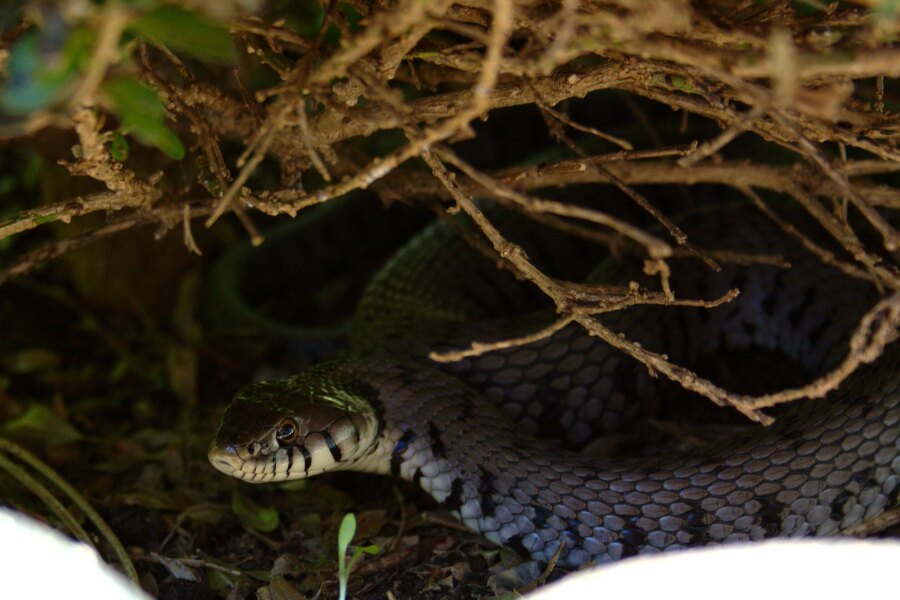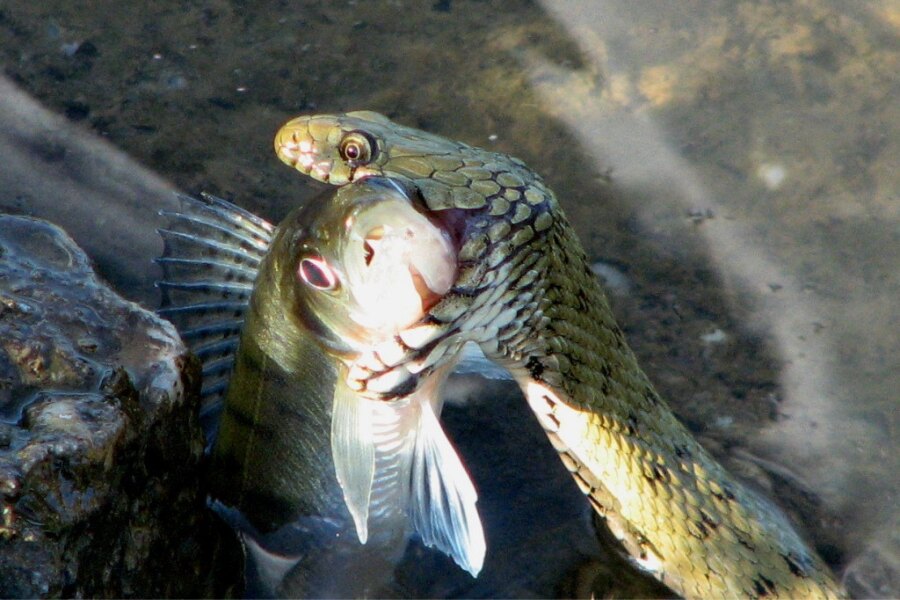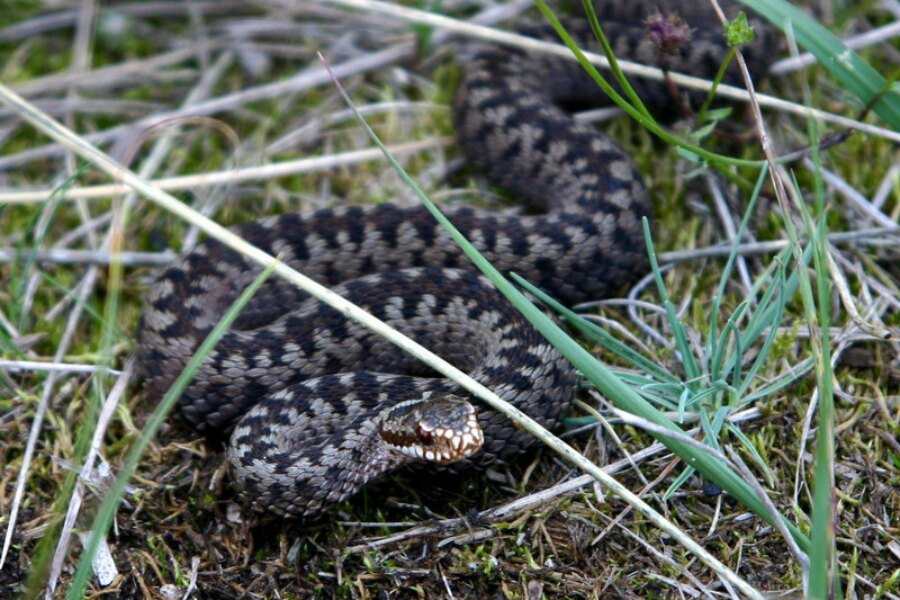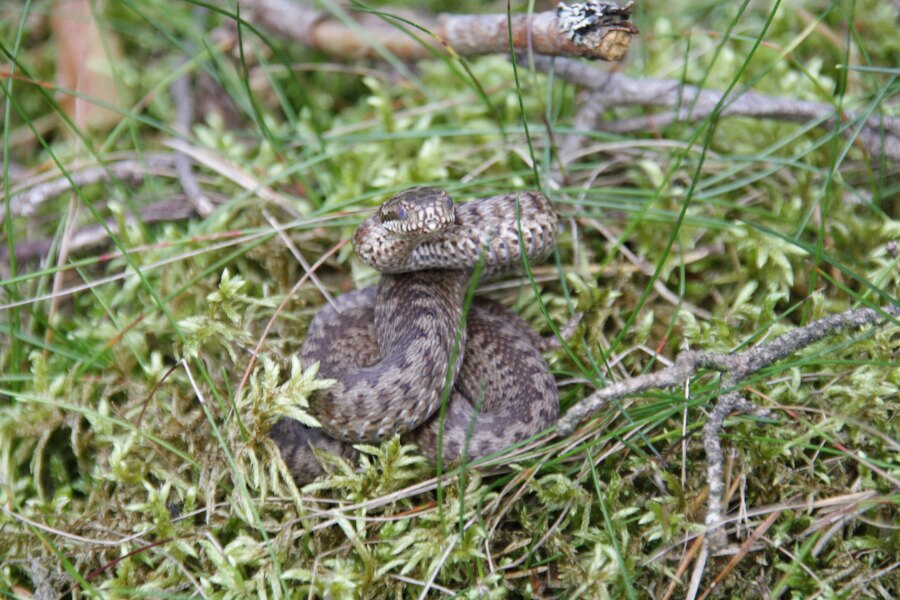(Non-)venomous snakes in the Czech nature and first aid in the event of a bite
There are only 5 species of snakes in Czech nature, 4 of which are representatives of non-venomous snakes. The last representative is the viper, which is the only poisonous snake in our country. Despite its reputation, the viper is much less dangerous than we know from pub stories. Can you distinguish it from other snakes in our nature? And do you know how to react to its bite?
1) Grass snake
The grass snake is the most widespread snake in our country and you can meet it throughout the territory of the Czech Republic. You can reliably recognize it by the color of its head, which has typical light to yellow crescent-shaped spots. In addition, these spots are lined with black on both sides.
The snake's body can be brown, gray or bluish. The underside of the snake is usually black with irregular white spots. In terms of its length, it ranks rather among the smaller representatives in the snake kingdom, males grow between 50 and 85 cm in length, while females, on the other hand, are usually larger with a length of 60 to 150 cm.
The collared snake is most often found around water, mainly because it is a relatively good swimmer. In the vicinity of stagnant and flowing water, it mainly lurks for amphibians, lizards and insects. Common frogs (grass frogs) and toads are the most common prey.

The most widespread snake in Czech nature is the grass snake.
2) Aesculapian snake
This species of snake is found in only a few places in the Czech Republic. You can come across it, for example, in the White Carpathians, Podyjí and Karlovy Vary. The Aesculapian snake opted for yellow and olive colors when choosing camouflage.
Its entire body is covered with small light spots, its belly is light gray to yellowish. A great interest is the coloring of the young, which with their coloring are significantly different from adults and look more like grass snakes. The Aesculapian snake usually grows between 90 and 140 cm in length.
The Aesculapian snake's diet consists mainly of rodents, amphibians, lizards and birds. Eggs or baby birds are particularly easy prey for the snake.
3) Dice snake
If you would like to see this snake in the wild, then you should definitely go near larger rivers. The dice snake (or water snake) is most often found in the Berounka, Sázava, Morava and Dyje basins.
The coloration is usually brown, but other color shades are also seen. The brown base is then dominated by dark and light spots, which resemble a checkerboard in their location. The belly is black and white with spots that resemble cubes or stripes. These spots often create checkering and sometimes a hint of black streaking. The dice snake most often grows to sizes from 80 to 100 cm.
As we mentioned at the beginning, the dice snake is very attached to the surrounding water, especially to rivers, and does not like stagnant and muddy water. The main component of its diet is fish and amphibians.

The dice snake is most often found around water.
4) Smooth snake
The last representative of non-venomous snakes is the smooth snake, which can resemble the appearance of a viper by its coloring. You can find this snake throughout the territory of the Czech Republic, it enjoys the presence of bushes and stones. The basic background is brown and gray, on which small brown spots stand out. These spots are lined up and can give the impression of uniform bands.
You can distinguish it from a viper especially upon closer inspection. The spots mentioned above do not form a continuous stripe, as is the case with the viper. The smooth snake grows to a size of 50 to 70 cm. The main food component is lizards, occasionally rodents and insectivores.
5) Common viper
After harmless snakes we now come to our only venomous representative of the serpent kingdom. Apart from the lowlands, the common viper (or adder) can be found in almost the entire territory of the Czech Republic. Males and females are distinguished by their coloring. Males are rather grey-brown or silvery in color with a very prominent dorsal stripe. In contrast, females are more brown to red with a less visible dorsal stripe.
The main distinguishing mark of the viper, i.e. the zigzag line, is made up of connected rhombuses. However, not all vipers have this main feature clearly visible, for example there are completely black specimens. The common viper grows from 60 to 75 cm in length.
The viper prefers moist and cooler places with access to sunlight. You will typically find it at the edge of the forest or on a rocky slope. It doesn't like lowlands, you can usually only find it in medium and higher locations. The main food is small mammals, followed by lizards and frogs.

The common viper is the only poisonous snake in the Czech countryside.
How dangerous is the bite?
When bitten, the most important thing is to keep a calm head and quickly find out what kind of snake has just tasted you. It may happen that the snake just wanted to drive you away from its territory and so decided to teach you a small lesson. Although a snake bite is unpleasant and painful, it is certainly not life-threatening.
If you got into a cross with a viper, it is possible that, like a snake, it only bit you threateningly, because it will not waste its precious venom on you. It is also possible that it injected the poison into your shoes or clothes and then you are not in any danger. But it's good to know that even if the viper really releases its venom into you, then a healthy adult has nothing to worry about. A quadruple dose of poison would be required to cause serious health complications.
What are the symptoms of poisoning?
Of the less serious ones, it is, for example, pain at the site of injury, local swelling and swelling of local lymph nodes. Moderate to severe poisoning is relatively rare, but if the following symptoms appear, it is necessary to pay attention and seek medical attention.
- nausea,
- stomach ache,
- vomiting,
- diarrhea,
- chills or high temperature.
Allergy sufferers must be especially careful, for whom swelling in the area of the lips, tongue and cheeks can cause breathing difficulties. In severe cases, disturbances of consciousness and bluish discoloration of the skin may occur.

Do you know how to react when bitten by a viper?
First aid for bites
- Calm the patient and immobilize the affected limb.
- Disinfect the wound and let it bleed freely (some of the poison will wash out).
- Place the affected limb below the level of the heart (hand hanging from the stretcher).
- Cool the area around the wound (the limb will start to swell soon).
- Take the patient to the hospital.
The 3 most common myths about snake bites
There are a lot of myths about snakebite first aid. We have selected for you the most dangerous ones that can do more harm than good.
1) I will strangle the limb and prevent the flow of poison.
Do not strangle the affected limb under any circumstances. At best, you can cause the person in question temporary problems, at worst, they can lose a limb because of you. And that's completely unnecessary, because it's proven that tourniquets can't stop the spread of poison.
2) Fire works best against poison!
By cauterizing the wound, you will only harm the patient again, without any benefit. If you want to disinfect the wound, it is better to use classic disinfectants.
3) I'll suck up the poison, no worries!
You may suspect that this will not be the right way to treat the wound either. You will not help the bitten person at all, and besides, you are exposing yourself to unnecessary risk. The poison can enter your body through small wounds in your mouth and suddenly there is another patient with poisoning in the world.
Readers are further interested



































































































































